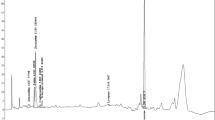Abstract
The aim of the work was to characterize the basic chemical composition including polyphenols of seedless industrial dried black currant pomace from two subsequent harvest seasons, 2006 and 2007. Pomace after removing seeds was separated into three fractions: with particles smaller than 0.8 mm, 2–5 mm and greater than 5 mm. The pomace was analyzed for dry substance, protein, fat, ash, total dietary fiber (TDF), soluble solids content, acidity, organic acids, saccharides and polyphenols. In addition, the antioxidant activity of the pomace was assayed by the DPPH method. All the fractions were characterized by a high content of total dietary fiber above 63% and a low content of saccharides below 3.15% and acidity below 3.2%. The composition of polyphenol compounds of all the fractions was qualitatively determined, yet it was shown that the fraction of the pomace of 2–5 mm is characterized by the greatest content of phytocompounds, of which anthocyanins constitute about 90% of the polyphenols determined. Moreover, the presence of myricetin and quercetin glycosides as well as considerable quantities of myricetin and quercetin aglycones was found in the pomace. The pomace had a high antioxidant activity ranging from 93.3 to 126.5 μM TEAC/g. It was also found that the content of most polyphenol compounds investigated, as well as protein, ash, TDF, acidity and saccharides, was statistically dependent on the type of fraction.


Similar content being viewed by others
References
Anttonen MJ, Karjalnen RO (2006) J Agric Food Chem 54:7530–7538
AOAC (1995) Method 920.152: protein in fruit products, Kjeldahl method. In: Official method of analysis, 16th edn. AOAC, Arlington
AOAC (1995) Method 930.09: ether extract of plants. In: Official method of analysis, 16th edn. AOAC, Arlington
AOAC (1995) Method 932.12: soluble solids in fruits and fruit products. In: Official method of analysis, 16th edn. AOAC, Arlington
AOAC (1995) Method 940.26: ash of fruits and fruit products. In: Official method of analysis, 16th edn. AOAC, Arlington
AOAC (1995) Method 942.15: acidity (titratable) of fruit products. In: Official method of analysis, 16th edn. AOAC, Arlington
AOAC (1995) Method 985.29: total dietary fiber in foods enzymatic-gravimetric method. In: Official method of analysis, 16th edn. AOAC, Arlington
Boccorh RK, Paterson A, Piggott JR (1998) Z Lebensm Unters Forsch A 206:273–278
Brennan Rex M, Hunter EA, Muir DD (2003) Food Res Int 36:1015–1020
Buchert J, Koponen JM, Suutarinen M, Mustranata A, Lille M, Torronen R, Poutanen K (2005) J Sci Food Agric 85:2548–2556
Central Statistical Office (2006) Statistical yearbook of agriculture and rural areas 2006. ZWS, Warszawa
d’Ischia M, Panzella L, Manini P, Napolitano A (2006) Curr Med Chem 13:3133–3144
Erlund I, Freese R, Marnieli J, Hakala P, Alfthan G (2006) Nutr Cancer 54(1):13–17
Ghosh D, McGhie TK, Zhang J, Adaim A, Skinner M (2006) J Sci Food Agric 86:678–686
Kapasakalidis PG, Rastall RA, Gordon MH (2006) J Agric Food Chem 54:4016–4021
Kim D-O, Lee KW, Lee HJ, Lee CY (2002) J Agric Food Chem 50:3713–3717
Kunachowicz H, Nadolna I, Przygoda B, Iwanow K (2005) Food composition tables. Wydawnicto Lekarskie PZWL, Warszawa, pp 302–309
Landbo AK, Meyer AS (2001) J Agric Food Chem 49:3169–3177
Larrauri JA (1999) Trends Food Sci Technol 10:3–8
Lee ER, Kang GH, Cho SG (2007) Rec Pat Biotechnol 1:139–150
Matsumoto H, Hanamura S, Kawakami T, Sato Y, Hirayama M (2001) J Agric Food Chem 49:1541–1545
Matta-Riihinen KR, Kamal-Eldin A, Mattila P, Gonzalez-Paramas M, Torronen R (2004) J Agric Food Chem 52:4477–4486
Miyataa M, Takano H, Takahashi K, Sasakib YF, Yamazoea Y (2002) Cancer Lett 183:17–22
Moyer RA, Hummer KE, Finn CE, Frei B, Wrostland RE (2002) J Agric Food Chem 50:519–525
Nawirska A, Kwaśniewska M (2004) Acta Sci Pol Technol Aliment 3(1):13–20
Nawirska A, Sokół-Łętowska A, Kucharska AZ (2007) Żywność 4(53):120–125
Piry J, Pribela A, Durcanska J, Farkas P (1995) Food Chem 54:73–77
Raffo A, Paoletti F, Antonelli M (2004) Eur Food Res Technol 219:360–368
Rubinskiene M, Viskelis P, Jasutiene I, Viskeliene R, Bobinas C (2005) Food Res Int 38:867–871
Shahidi F, Naczk M (2004) Phenolics in food and nutraceuticals. CRC Press, Boca Raton, pp 136–141
Siksnianas T, Stanys V, Sasnauskas A, Viskelis P, Rubinskiene M (2006) J Fruit Ornament Plant Res 14(Suppl 2):265–271
Singleton VL, Rossi JA (1965) Am J Enol Vitic 16:144–158
Skrede G, Wrolstad RE (2002) Flavonoids from berries and grapes. In: Shi J, Mazza G, Maguer Le (eds) Functional foods. CRC Press, Boca Raton, pp 71–133
Skrede G, Wrolstad RE, Durst RW (2000) J Food Sci 65(2):357–364
Slimestad R, Solheim H (2002) J Agric Food Chem 50:3228–3231
Yoshimoto M, Okuno S, Yoshinaga M, Yamakawa O, Yamaguchi M, Yamada J (1999) Biosci Biotechnol Biochem 63(3):537–541
Acknowledgments
The research was financially supported by 6th Framework Program EU project “ISAFRUIT.” The ISAFRUIT project is funded by the European Commission under the Thematic Priority 5-Food Quality and Safety of the 6th Framework Programme of RTD (contract no. FP6-FOOD-CT-2006-016279).
Author information
Authors and Affiliations
Corresponding author
Additional information
Disclaimer: The views and opinions expressed in this publication are purely those of the writers and may not in any circumstances be regarded as stating an official of European Commission.
Rights and permissions
About this article
Cite this article
Sójka, M., Król, B. Composition of industrial seedless black currant pomace. Eur Food Res Technol 228, 597–605 (2009). https://doi.org/10.1007/s00217-008-0968-x
Received:
Revised:
Accepted:
Published:
Issue Date:
DOI: https://doi.org/10.1007/s00217-008-0968-x




